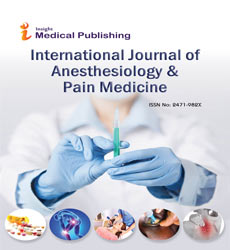Significant Techniques Applicable for the Management of Chronic Pain
San Arrie
San Arrie*
Department of Anesthesiology, Yale School of Medicine, New Haven, Connecticut, United States
- *Corresponding Author:
- San Arrie
Department of Anesthesiology,
Yale School of Medicine,
New Haven,
Connecticut,
United States,
E-mail: sanarrie@yale.edu
Received Date: September 03, 2021; Accepted Date: September 17, 2021; Published Date: September 24, 2021
Citation: Arrie S (2021) Significant Techniques Applicable for the Management of Chronic Pain. Int J Anesth Pain Med Vol.7 No.5:e102.
Abstract
Description
Chronic pain is a significant concern for clinicians as well as patients. Pain can rarely be completely eliminated ofr an extended period of time. Asa result, patients and doctors should discuss about treatment goals including pain reduction, better function, and improved quality of life. Chronic pain care that treats co-occurring mental illnesses (e.g., depression, anxiety) and includes appropriate nonpharmacological and complementary therapies for symptom management has the greatest results.
Non-prescription and prescription drug therapy
Medicines such as Tylenol (acetaminophen) and Non-Steroidal Anti-Inflammatory Drugs (NSAIDs) like aspirin, ibuprofen, and naproxen can help to reduce mild pain. NSAIDs and acetaminophen can relieve discomfort from muscular aches and stiffness, and NSAIDs also reduce inflammation (swelling and irritation). Topical pain killers, such as creams, lotions, and sprays, applied to the skin to reduce pain and inflammation caused by aching muscles and arthritis, are also available.
If topical pain killers don't work, then stronger medications like muscle relaxants, anti-anxiety drugs (diazepam (Valium)), antidepressants (duloxetine (Cymbaalt) for musculoskeletal pain), NSAIDs (celecoxib (Celebrex)), a short course of painkillers (codeine, fentanyl (Duragesic, Actiq) (Lorcet, Lortab, and Vicodin) can be prescribed. Swelling and inflammation can be reduced by a small number of steroid injections at the location of a joint problem. For spinal stenosis or lower back discomfort, an epidural may be used.
Local medicine can be used to block a group of nerves that produce pain in a specific organ or body region. Nerve blocks are available in a variety of forms, but they aren't always helpful. Blocks are frequently impossible, too hazardous, or not the right solution to the situation.
Another form of pain management is Patient-Controlled Analgesia (PCA). The patient can self-administer a premeasured dosage of pain medication laced with opiates by pressing a button on a computerized pump. A tiny tube connects the pump to a small tube that permits medication to be administered intravenously (into a vein), subcutaneously (just beneath the skin), or into the spinal region. It is commonly used in hospitals to treat post-traumatic or post-surgical pain and the pain caused by terminal cancer.
Injections into trigger points
Trigger point injection is a technique used to treat painful muscular trigger points, which are knots that form when muscles are not relaxed. A healthcare professional injects a local anesthetic that contains a steroid into a trigger point using a tiny needle during this treatment (sterile saltwater is injected sometimes). The trigger point is rendered inactive and, the pain is relieved as a result of the injection. Typically, a short course of therapy will provide long-term relief.
Botox (Onabotulinumtoxin A) is a toxin that inhibits nerve impulses from reaching the muscles. Chronic migraine headaches can also be relieved by injecting them. Multiple injections across the head and neck are given every 12 weeks, and the treatment can relieve pain for up to three months.
Surgical implants
Surgical implants help to control pain if medications and physical therapy have failed to provide appropriate pain relief. There are two major types of pain-controlling implants:
Intrathecal drug delivery: It is also known as infusion pain pumps or spinal drug delivery systems, is a kind of Intrathecal drug delivery device. A pocket large enough to contain a medication pump is created under the skin by the surgeon. A catheter is inserted, which transports pain medication from the pump to the Intrathecal region around the spinal cord. Medicines like morphine or a muscle relaxant are delivered directly to the spinal cord, where pain signals travel.
Spinal cord stimulation implants: Spinal cord stimulation involves sending low-level electrical impulses to the spinal cord or particular nerves to prevent pain signals from reaching the brain. This technique is very effective for back and limb aches.
Psychological treatment
Anger, melancholy, hopelessness, and despair are common emotions experienced by people who are in pain. Pain can change one's personality; interrupt sleep, and cause problems at work and in relationships. Depression and anxiety, as well as a lack of sleep and stress, can all exacerbate pain. Psychological therapy is a non-drug technique for treating pain directly by lowering excessive levels of physiological stress, which can worsen the pain.
Open Access Journals
- Aquaculture & Veterinary Science
- Chemistry & Chemical Sciences
- Clinical Sciences
- Engineering
- General Science
- Genetics & Molecular Biology
- Health Care & Nursing
- Immunology & Microbiology
- Materials Science
- Mathematics & Physics
- Medical Sciences
- Neurology & Psychiatry
- Oncology & Cancer Science
- Pharmaceutical Sciences
